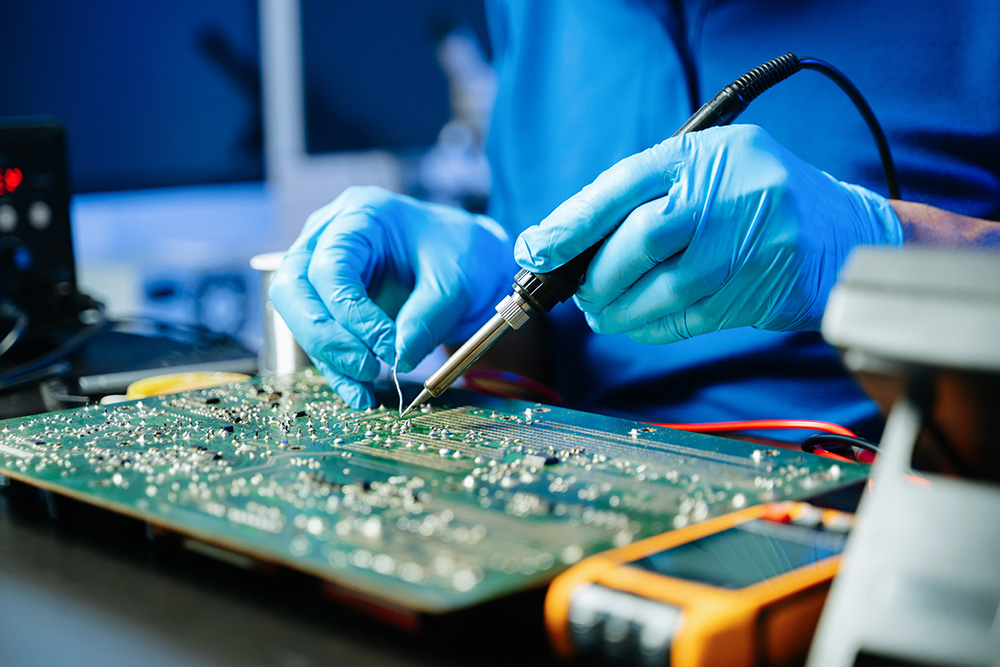Flux Remover: A Must-Have for Every Electronics Lab
When it comes to electronics manufacturing or repair, precision is non-negotiable. From assembling delicate components on a printed circuit board (PCB) to troubleshooting malfunctioning parts, even the tiniest contaminants can disrupt functionality.
That's why flux remover is essential. Whether you're a seasoned electrical engineer, a bench technician, or running a commercial electronics lab, understanding what flux remover is and why it's indispensable can improve your workflow, enhance safety, and extend the life of your components.

What Is Flux and Why Must It Be Removed?
Flux is a chemical agent used during the soldering process. It helps clean oxidation from metal surfaces, improves solder flow, and ensures stronger, more reliable joints. However, after soldering, flux residue remains on the circuit boards. Left untreated, this residue can lead to several problems:
- Corrosion: Flux residue attracts moisture, which can cause components to corrode over time.
- Electrical Leakage: Residual flux can cause current to leak across the board, creating short circuits or signal interference.
- Reduced Lifespan: The reliability of the PCB drops significantly, increasing the risk of failure in critical applications.
That's where flux remover comes in. This solvent is specifically designed to thoroughly clean the surface of circuit boards, eliminating residue and minimizing the risk of contamination.
How Flux Remover Works
Flux removers are specially formulated cleaning agents that dissolve and lift flux residue, oils, dirt, and other contaminants from electronic components. Some are aerosol-based, while others come in liquid form for use with brushes or ultrasonic cleaners.
Unlike general-purpose cleaners or degreasers, a flux remover is engineered for delicate components. It effectively removes residues without damaging the materials or leaving conductive deposits behind.
Many labs debate whether to use a contact cleaner or flux remover. Still, it's important to note that while contact cleaners eliminate dirt or corrosion from connectors, they are not always strong enough to remove stubborn flux. Choosing the right cleaning agent is key.
Health, Safety, and Regulatory Considerations
When working with chemical cleaning products, reducing chemical exposure is a crucial aspect of lab safety. Solvents used in flux removers have established exposure limits, often defined by the Threshold Limit Values (TLVs) of the American Conference of Governmental Industrial Hygienists (ACGIH). These are usually measured in parts per million (ppm), representing the concentration level of a substance considered safe for an 8-hour day or a 40-hour work week.
The TLV of governmental industrial hygienists, as set by ACGIH, is not just a guideline. It shapes the safety practices of laboratories worldwide. It ensures personnel are not overexposed to volatile organic compounds. For instance:
- The solvents used are generally set at a maximum ppm level.
- Exposure should be in addition to recommended personal protective equipment, including masks, face shields, and respirators.
- Depending on the cleaning product used, laboratories may also require special ventilation systems and must ensure that personnel maintain exposure levels below the recommended limits.
Choosing the Right Flux Remover for Your Lab
Not all flux removers are created equal. Here are some factors to consider when selecting the right one for your needs:
- Compatibility with PCB Materials: Ensure the cleaner does not degrade plastics, labels, or coatings on the printed circuit board (PCB).
- Evaporation Rate: A faster evaporation rate reduces drying time and improves efficiency.
- Residue-Free Finish: The cleaner should leave no film or conductive trace.
- Compliance with Safety Standards: Look for products that meet ACGIH guidelines and include usage instructions for the proper use of personal protective equipment.
- Application Method: Consider whether you need a degreaser contact cleaner in aerosol form, a brush-on solution, or one that is compatible with ultrasonic cleaning equipment.
Every lab must strike a balance between performance and safety. Selecting a flux remover that delivers a clean board without compromising the health of technicians or violating compliance standards is non-negotiable.
Protect Your Electronics Today
Best Practices for Using Flux Remover
To make the most of your flux remover, follow these best practices:
- Work in a Well-Ventilated Area: Proper ventilation ensures you remain within the safe exposure limit.
- Wear Protective Equipment: As recommended by the Conference of Governmental Industrial Hygienists, always use masks, face shields, or respirators to protect yourself.
- Apply Precisely: Target flux residue directly. Avoid over spraying or saturating nearby components.
- Use Appropriate Tools: A lint-free cloth or soft brush helps dislodge particles without damaging circuitry.
- Dispose Responsibly: Follow local regulations for hazardous waste disposal, as flux remover can be flammable or toxic.
Why Every Electronics Lab Needs Flux Remover
A modern electronics lab deals with hundreds, sometimes thousands, of boards daily. Whether you're working with advanced processors or basic resistors, the need for clean, reliable connections is universal. Dirty or flux-laden PCBs can compromise product reliability, increase customer returns, and damage reputations.
Regulations and standards for electronics manufacturing are becoming increasingly stringent. Labs must adhere to safety and quality metrics, including cleanliness levels for PCBs. A dedicated flux remover isn't just a helpful product, it's a requirement for success in a quality-driven industry.
Discover the Cleaning Power Behind Your Success
Choosing the right flux remover is more than just selecting a solvent. It's about protecting your circuits, your team, and your reputation. At Stoner Critical Cleaning, we specialize in formulating high-performance solutions that meet the stringent demands of today's electronics labs.
If you're ready to elevate your PCB cleaning game while staying compliant and efficient, let us help. Contact us today to discover the ideal flux remover for your laboratory's specific needs.
